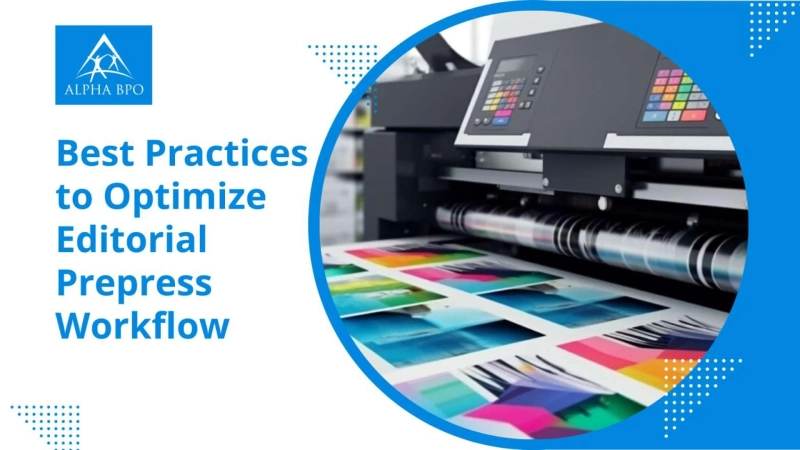The term pre-press used by the printing and publishing industries connects the creative vision to the final printed masterpiece. It encompasses the detailed process of adjusting images and text and creating high quality print files, laying the foundation for a flawless print outcome. However, editorial prepress errors can lead to printing delays and reprints, accounting for upto 30% of annual Value Added Sales (VAS). So, it is important to adhere to best practices within editorial prepress solutions to streamline workflows and minimize costs in the dynamic printing industry.
Today's post will disclose the best practices to optimize the editorial prepress workflow, ensuring a smooth and efficient printing process while reducing errors and costs. Know how and in what ways editorial prepress services can help you print for success!
Check Out 10 Best Practices for Effective Editorial Prepress Workflows
10 Best Practices for Effective Editorial Prepress Workflows
1. Fine-Tune Your Graphics:
2. Choosing Appropriate Software is a Must:
3. Perfect Your Proofreading:
4. Proper Spacing for Visual Appeal and Readability
5. Accurate Color Representation Helps
6. Preflighting - The Final Check for Print Perfection
7. Perfecting Bleeds for Brilliant Printing
8. Choose the Perfect Paper
9. PDF Quality Matters
10. Run a Final Check for The Best Results
Efficient prepress workflows are essential for a smooth printing process. Here are ten best practices that you can implement to optimize your prepress editorial workflows and ensure effective print results:
1. Fine-Tune Your Graphics:
For achieving crisp and professional-looking prints, choosing the right image quality is key. Aim for a resolution between 250 and 300 dpi (dots per inch) to ensure clarity and sharpness. Avoid resizing images by more than 20%, as it can greatly diminish their quality and result in blurry or pixelated prints.
Instead, strive to maintain the original size of the image and make minimal adjustments to preserve important details. By following these guidelines, you can avoid printing issues and ensure your graphics truly shine.
2. Choosing Appropriate Software is a Must:
Efficient prepress workflows depend on selecting the appropriate software for the job. While familiar tools like Microsoft Word or PowerPoint may suffice for everyday documents, professional printing demands more robust solutions. Thankfully, expert editorial prepress services offer specialized features for image manipulation, design, vector graphics, and other versatile design capabilities.
These programs provide advanced features and precise control over elements crucial for high-quality printing. Choosing the right software ensures design consistency, overcomes challenges, and streamlines your prepress for maximum business efficiency.
3. Perfect Your Proofreading:
Thorough proofreading is an important aspect of prepress editorial services. While captivating design elements grab attention, error-free text is equally important as it showcases the credibility of your work and leaves a good impression. Make sure to avoid avoidable prepress errors that overshadow your brilliant work.
Issues like text overflows, obscured content by images, or misplaced text can surface after initial proofreading processes during typesetting. Prepress printing services prioritize comprehensive content review to prevent costly reprints and delays. They examine typos, grammatical errors, and layout inconsistencies, guaranteeing a polished final product and a hassle-free workflow.
4. Proper Spacing for Visual Appeal and Readability
The visual appeal and readability of text in print publications require careful attention. Prepress editorial services adhere to established typographic practices, including simple line spacing adjustments. These services involve fine-tuning elements like leading (space between lines), tracking (letter spacing), and kerning (space between specific letter combinations).
By carefully adjusting these parameters, editors can create a unique and balanced text layout that improves readability and sets your design apart. Optimal spacing ensures rich aesthetics and a cohesive flow in your text while preventing printing issues.
5. Accurate Color Representation Helps
Achieving accurate color representation in print requires vigilance during prepress editorial services. There is a fundamental difference between how colors are displayed on screens (RGB) and how they are reproduced by printers (CMYK). Screens blend light to create colors, while printers use inks to subtract them.
Prepress services run checks to ensure your design is seamlessly recreated on paper from the screen. Editors protect against unexpected color variations and guarantee a visually consistent final product by verifying color modes and potentially converting from RGB to CMYK. This proactive color management approach streamlines the prepress workflow and minimizes the risk of costly reprints.
6. Preflighting - The Final Check for Print Perfection
Preflighting is the ultimate step in prepress editorial services, ensuring everything is in order before printing. Depending on your preference, it can be done manually or with software. This process examines aspects like font consistency, color accuracy, and image resolution, preventing potential issues like blurry prints, incorrect layouts, or missing elements.
Preflighting under prepress solutions serves as a demo run-through for your text, eliminating the hassle of reprinting. By avoiding unnecessary expenses, it guarantees a premium-quality final printed product.
7. Perfecting Bleeds for Brilliant Printing
Bleeds are essential for achieving visually stunning edge-to-edge printing. Editors extend images or backgrounds slightly beyond the intended page size to optimize the prepress process.
Since printers cannot print right to the edge due to mechanical limitations, bleeds prevent unwanted white margins with some trimming variations. Prepress editorial standards include bleed requirements to ensure a high-quality, professional-looking printed piece, free from any trimming-related complications.
8. Choose the Right Paper
Selecting the right paper stock is a critical step in the prepress workflow. Beyond aesthetics, your paper choice significantly impacts the feel and visual appeal of the final product. Editorial prepress services play a vital role in guiding this decision. Understanding the characteristics of different paper types helps you make an informed choice.
Consider factors such as weight, texture, finish, and compatibility with printing techniques to ensure that the chosen paper complements your design and improves the overall printing experience. Make your paper choice wisely, as it can make a difference in the final product.
9. PDF Quality Matters
Imagine opening a PDF document only to find blurry text and pixelated images. It's not the ideal reading experience, right? Just as you wouldn't tolerate it, your readers expect the best. Relying solely on default settings from an online editor won't cut it when achieving seamless printing results.
Most printers have specific requirements for the final PDF quality. Editorial prepress services understand these printer specifications and ensure optimal workflows by exporting PDFs accordingly. This attention to detail guarantees high-resolution files and eliminates printing pitfalls, ensuring the highest quality output.
10. Run a Final Check for The Best Results
Thoroughly examining your files before sending them for final printing is crucial to optimizing the editorial prepress workflow. Prepress editorial services play a key role in this workflow by addressing important aspects. They export the final document as a high-resolution PDF to guarantee clarity and avoid faulty printing.
Also, prepress services send images separately, regardless of embedding, to provide the printer with readily accessible, high-quality files. They also verify that the source file uses fonts readily available to the printer, eliminating font substitution issues. By addressing these concerns, prepress optimization minimizes delays, improves communication, and ensures the printer has all the necessary resources for a successful printing run.
Achieve Excellent Prints with Best Practices for Editorial Prepress!
Having the knowledge of evolving trends and advancements is necessary for success in dynamic digital prepress services. Please correct any prepress to avoid costly delays and reprints. Adopting the best practices for editorial and prepress solutions outlined in this blog allows you to optimize your workflow, minimize errors, and ensure seamless printing. Consider partnering with a trusted prepress service provider to maximize efficiency and achieve flawless results.
Implementing these best practices allows you to simplify your editorial prepress workflow, reduce errors, and attain a seamless printing process. Contact a reputable and professional editorial and prepress agency to learn more about their services and promote your printing experience.



